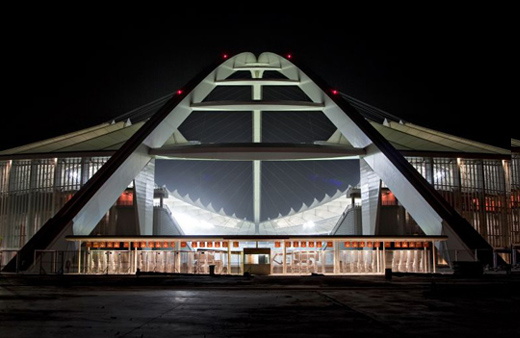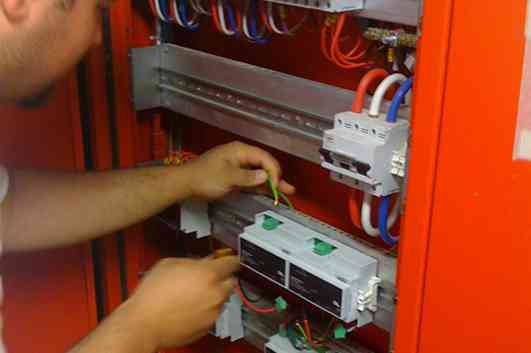- Home
- System Archive
- DURBAN STADIUM RAISES THE BAR
DURBAN STADIUM RAISES THE BAR

Durban’s Moses Mabhida Stadium is spectacular. From the soaring arched spine to the translucent membrane cladding, it’s an inspired design. The same attention to detail went into the lighting and control systems.
Designed to be active 365 days a year, it is able to comfortably seat 70 000 fans with clear line-of-sight of the pitch, and has the potential to expand to 85 000 seats for larger scale events such as the Olympic Games.
The entire precinct is geared to being a dynamic entertainment node for the city of Durban.
It will include a railway station, parking, and park-and-ride facilities.
More than just a stadium
The precinct incorporates additional sports fields and facilities, shops and restaurants, children’s play areas, an amphitheatre, a pedestrian walkway linking the complex to the beach, and even a funicular to take visitors to a viewing platform 106 metres above the pitch to experience the spectacular views of the city and the ocean.
One of the unique aspects of what is now called the Moses Mabhida Stadium is that it is the only stadium in the history of South Africa to have been designed through a competition.
The winner of the competition, the Ibhola Lethu consortium, drew their inspiration from the South African flag and the history it represents, to design an arch which spans the length of the arena, with two legs on the south side merging into a single leg on the north side to symbolise the unity of a nation once divided.
Steel and Teflon
The 350m long free-span steel arch weighing 2 600 tons (the equivalent of 2 600 average size cars) was designed by one of the world’s leading stadium architects, Gerkan, Marg and Partner (GMP) of Germany.
Attached to the arch by 95 mm diameter steel cables is a roof comprising 46 000 m2 of Teflon-coated glass fibre membrane, which produces a translucent glow when the stadium is lit.
Completed ahead of schedule in October last year, the arena has already hosted a number of high-profile matches, including a capacity crowd packing the stadium for a showdown between Kaizer Chiefs and their legendary rival, Mamelodi Sundowns.
Julie-May Ellingson, Head of the Strategic Projects Unit and 2010 Programme for the City of Durban, said “We were extremely pleased with the success of the first events and have every faith that the stadium will be an enormous asset, not only to Durban, but to South Africa.”

Electrosonic’s involvement
With large projects such as the Moses Mabhida Stadium, there is a long period of planning and design before construction and installation can commence. Consultants from around the world were involved in addressing various aspects of the project and the design had not been finalised when Electrosonic and other companies were invited to propose a lighting control solution.
The brief
The control concept was to provide a simple user interface for switching lighting and power circuits to the various areas of the stadium. A flexible system was required that could be customised to suit the various requirements.
Flexibility meant that not only should the system allow for switching power for the lighting and air handling units in the VIP suites, etc, but it should also have the facility to interface between different disciplines – from power switching to dimming, to controlling DALI systems and DMX systems, to interfacing into BMS systems and even evolving to run most of the mundane tasks through programming automatic features. The obvious choice to meet these varied requirements was a Crestron control system.
The system installation
Electrosonic SA supplied equipment to various contractors to install and integrate with other equipment.
The design evolved as more information became available and the final result was 2 x Crestron AV2 processors linked via LAN to 8 x DINAP2 Processors, which control 351 x Crestron relays with 8 contacts each, giving control over 2 800 individual loads.
The system was also designed to allow the control room to switch power to individual areas or to put the stadium in specific ‘modes’ to provide flexibility and ease of use for the operators.
Overall control is maintained by the master control room in the basement, although on match days when operators need to be guided by activity on the pitch, control can be handed to the second control room (VOC) located on level 5 of the Stadium.
The loads vary from flood lights to bowl lights, and general area lighting in passages, toilets, kitchens, dressing rooms, parking areas, private boxes, etc.
General illumination controls toilets, stairwells, parking areas as well as the private boxes. Kitchen areas are also included and the control room can ensure that all the cookers and stoves are disconnected from power after an event.
The bowl lighting comprises fluorescent fixtures which provide general illumination in the stadium by shining up into the sails as well as indirect illumination for the seating.
The 940 bowl lights are controlled via DALI, with lights dimmed to preset scenes for different scenarios. This is executed via two of the Crestron DINAP2 controllers which communicate on the DALI bus to 10 x Helvar 910 DALI Routers. There are 20 DALI Universes controlled from the Crestron processor to control the bowl lighting used to provide illumination for the seating areas.
The flood lights are programmed to switch to the different lighting intensities (brightness) required by the various events taking place. For instance the floodlighting can be set up for
‘Training’, ‘National Matches’, ‘International Matches’, as well as ‘High Definition Matches’.
When any of these scenes is selected, the Crestron system will sequentially switch on the various flood lights required to ensure the correct Lux level for the cameras, as well as ensuring that the surge on the incoming power is minimised. This allows the operator to simply select the appropriate button and Crestron takes care of the rest.
The final aspect of the system is the control of the 1 320 LEDs that illuminate the arch of the stadium.
Various chases and scenes were programmed to ensure that the stadium is visible from quite a distance. These scenes can be scheduled to run at random times or can be triggered in real time. For instance, the LEDs may be triggered to run a specific scene when a goal is scored.
The LEDs are controlled by a Martin Maxxyz PC controller in the control room, which in turn is connected to 2 x Martin Ethernet-to-DMX boxes via a LAN connection. The LEDs are decoupled from the control circuits by means of Martin Opto Couplers.
The different looks and shows are programmed on the Martin Maxxys, which is triggered by the Crestron control system. The operators have access to these shows via the BMS (Building Management System) which is linked into the Crestron control system.
In terms of the amount of cabling required to complete the installation, Electrosonic supplied the various contractors with approximately 12 000 metres of Cresnet cable and 4 500 metres of DALI cable, not to mention the LAN which linked the various systems together.
A final word
Gerrie Coetzee, Manager of Electrosonic SA KZN confirmed that the system at the Moses Mabhida Stadium is the biggest single Crestron system installed to date.
“We have 10 individual processors linked together as one global system, and with all of the other items it amounts to more than 350 Cresnet devices in total. We pushed the boundaries to get the system to do more, and we knew without a doubt that Crestron would deliver the results.
“Using the Crestron system gives us the peace of mind to know that the system will give the client the flexibility and room for growth to handle any possible requirements that may arise.
“We are currently working with the stadium management team to further refine the system and add Roomview functionality to it,” he said.
EQUIPMENT LIST
• Crestron DIN8SW8 DIN Rail High Voltage Switch with Digital Inputs = 174 Relays
• Crestron CH-HRIO8-D9 x 56 Relays
• Crestron CH-HREL8-D6 x 121 Relays
• 2 x Crestron AV2 processors
• 2 x CNXB12 12-Button Designer Keypads
• 9 x CREDIN8HUB DIN Rail Cresnet Distribution Hub
• 2 x Enet1 Cards
• 8 x Crestron DINAP2 DIN Rail 2- Series Automation Processors
• 1 x Crestron TPS15GQM 15" Touchpanel
• 10 x Helvar 910 DALI Routers
• 1 x Martin Maxxyz PC controller
• 2 x Martin EtherDMX Interface 230
• 4 x Martin Opto 4 Channel Isolator
.
Photo of Moses Mabhida Stadium: Courtesy Mike van Heerden © Ethekwini Municipality
Posted in System Archive

